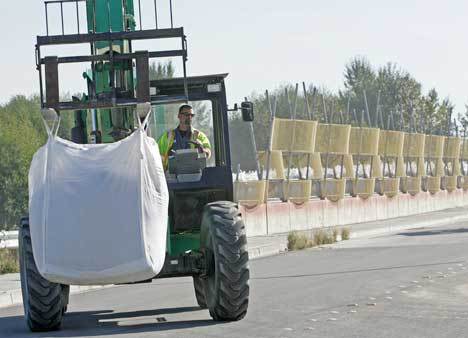Heather McIntosh and two dozen other Kent city employees used silly humor, energy drinks and motivation to make it through nearly 30 straight days of work filling giant sandbags, in preparation for possible flooding this winter.
“It helped knowing we were helping to, hopefully, save people’s homes and property,” McIntosh said in a phone interview Tuesday.
Twenty-two members of the public works department were honored for their work at the Nov. 17 City Council meeting.
“They worked around the clock for a month straight to fill 17,000 sacks that we hope will protect us from potential flooding,” said Don Millet, public works operations manager, at the Council meeting. “They basically lived up there. They were rained on and spent cold nights up there. It was a 24-7 operation and they did not stop until it was completed.”
Crews started the sandbag project Oct. 3 and finished Oct. 30.
City crews filled the 3,200-pound sandbags that were trucked and placed by contractors along a 12-mile stretch of the Green River. The bags increased the height of the levees by up to 3 feet and will enable the levees to handle river flows as fast as 13,900 cubic feet per second.
The Council gave the employees a standing ovation at the meeting after hearing comments from public works managers about the job the crews accomplished.
Councilman Ron Harmon said the employees deserved plenty of praise.
“They were able to jump right in and make a commitment to see if one crew couldn’t outdo the other,” Harmon said in a phone interview after the Council meeting. “It was a pretty awesome effort.”
Harmon stopped by the work site on a Sunday afternoon in October and came away impressed.
“They were feverishly working,” Harmon said. “They showed with team players working together how you can get it done. What a great bunch of employees. Our guys are all-stars.”
McIntosh was part of a 12-member crew that worked midnight-to-11:30-a.m. shifts to fill giant sandbags at a temporary work site along South 231st Way and Riverview Boulevard on the West Hill.
“They worked 11-hour shifts and took it on as a challenge and stayed ahead of the contractor,” said Greg Reed, city utilities superintendent. “They filled sandbags for 30 days straight, seven days a week.”
The King County Flood Control District and the County Council agreed last month to reimburse the city $2.5 million for the project.
Water leaking through a damaged abutment at the Howard Hanson Dam has yet to be resolved by the U.S. Army Corps of Engineers, the federal agency in charge of the flood-control dam. The leak increases the risk of flooding this winter in the Green River Valley and the cities of Kent, Auburn, Renton and Tukwila.
The federal government built the rock-and earth-fill Hanson dam in 1961 to control major flooding in the Green River Valley.
The problems with water storage behind the dam started when a 10-foot-wide depression formed on the embankment next to the dam after heavy rain in early January. The dam is about 25 miles east of Kent.
Corps officials estimate a 1 in 32 chance of flooding this winter compared to a 1 in 140 chance when the dam is fully operational. The corps installed a temporary grout curtain this fall along the abutment to reduce the odds of flooding to 1 in 25 from 1 in 3 with the leak. The sandbags placed by city crews along the levees put the odds at 1 in 32.
McIntosh said working conditions at the sandbag-filling site were tough when it rained.
“It was the thickest and slimiest mud,” she said.
McIntosh’s duties were to help move the filled sandbags from the sand-filling machine to forklifts.
“It was back-breaking,” she said.
Reed watched how hard the crews worked.
“They always had a positive attitude,” Reed said. “The whole city owes this group a debt of gratitude.”
Talk to us
Please share your story tips by emailing editor@kentreporter.com.
To share your opinion for publication, submit a letter through our website https://www.kentreporter.com/submit-letter/. Include your name, address and daytime phone number. (We’ll only publish your name and hometown.) Please keep letters to 300 words or less.

